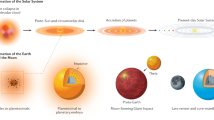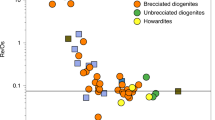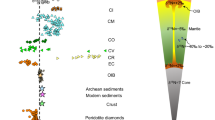Abstract
The degree to which efficient mixing of new material or losses of earlier accreted material to space characterize the growth of Earth-like planets is poorly constrained and probably changed with time. These processes can be studied by parallel modelling of data from different radiogenic isotope systems. The tungsten isotope composition of the silicate Earth yields a model timescale for accretion that is faster than current estimates based on terrestrial lead and xenon isotope data and strontium, tungsten and lead data for lunar samples. A probable explanation for this is that impacting core material did not always mix efficiently with the silicate portions of the Earth before being added to the Earth's core. Furthermore, tungsten and strontium isotope compositions of lunar samples provide evidence that the Moon-forming impacting protoplanet Theia was probably more like Mars, with a volatile-rich, oxidized mantle. Impact-driven erosion was probably a significant contributor to the variations in moderately volatile element abundance and oxidation found among the terrestrial planets.
This is a preview of subscription content, access via your institution
Access options
Subscribe to this journal
Receive 51 print issues and online access
$199.00 per year
only $3.90 per issue
Buy this article
- Purchase on Springer Link
- Instant access to full article PDF
Prices may be subject to local taxes which are calculated during checkout




Similar content being viewed by others
References
Yin, Q. Z. et al. A short timescale for terrestrial planet formation from Hf–W chronometry of meteorites. Nature 418, 949–952 (2002)
Kleine, T., Münker, C., Mezger, K. & Palme, H. Rapid accretion and early core formation on asteroids and the terrestrial planets from Hf–W chronometry. Nature 418, 952–955 (2002)
Schönberg, R., Kamber, B. S., Collerson, K. D. & Eugster, O. New W isotope evidence for rapid terrestrial accretion and very early core formation. Geochim. Cosmochim. Acta 66, 3151–3160 (2002)
Jacobsen, S. B. & Harper, C. L. Jr in Earth Processes: Reading the Isotope Code (eds Basu, A. & Hart, S.) 47–74 (AGU, Washington DC, 1996)
Halliday, A. N. Terrestrial accretion rates and the origin of the Moon. Earth Planet. Sci. Lett. 176, 17–30 (2000)
Cameron, A. G. W. & Benz, W. Origin of the Moon and the single impact hypothesis IV. Icarus 92, 204–216 (1991)
Canup, R. M. & Asphaug, E. Origin of the moon in a giant impact near the end of the Earth's formation. Nature 412, 708–712 (2001)
Yoshino, T., Walter, M. J. & Katsura, T. Core formation in planetesimals triggered by permeable flow. Nature 422, 154–157 (2003)
Rubie, D. C., Melosh, H. J., Reid, J. E., Liebske, C. & Righter, K. Mechanisms of metal-silicate equilibration in the terrestrial magma ocean. Earth Planet. Sci. Lett. 205, 239–255 (2003)
Stevenson, D. J. in Origin of the Earth (eds Newsom, H. E. & Jones, J. H.) 231–249 (Oxford Univ. Press, Oxford, 1990)
Halliday, A. N. & Porcelli, D. In search of lost planets – the paleocosmochemistry of the inner solar system. Earth Planet. Sci. Lett. 192, 545–559 (2001)
Humayun, M. & Clayton, R. N. Potassium isotope cosmochemistry: Genetic implications of volatile element depletion. Geochim. Cosmochim. Acta 59, 2131–2151 (1995)
Wetherill, G. W. in Origin of the Moon (eds Hartmann, W. K., Phillips, R. J. & Taylor, G. J.) 519–555 (Lunar Planetary Institute, Houston, 1986)
Taylor, S. R. & Norman, M. D. in Origin of the Earth (eds Newsom, H. E. & Jones, J. H.) 29–43 (Oxford Univ. Press, Oxford, 1990)
Allègre, C. J., Manhès, G. & Göpel, C. The age of the Earth. Geochim. Cosmochim. Acta 59, 1445–1456 (1995)
Lee, D.-C. & Halliday, A. N. Hafnium–tungsten chronometry and the timing of terrestrial core formation. Nature 378, 771–774 (1995)
Galer, S. J. G. & Goldstein, S. L. in Earth Processes: Reading the Isotope Code (eds Basu, A. & Hart, S.) 75–98 (AGU, Washington DC, 1996)
Hayashi, C., Nakazawa, K. & Nakagawa, Y. in Protostars and Planets II (eds Black, D. C. & Matthews, M. S.) 1100–1153 (Univ. Arizona Press, Tucson, 1985)
Sasaki, S. & Nakazawa, K. Metal-silicate fractionation in the growing Earth: energy source for the terrestrial magma ocean. J. Geophys. Res. 91, B9231–B9238 (1986)
Carlson, R. W. & Lugmair, G. W. in Origin of the Earth and Moon (eds Canup, R. & Righter, K.) 25–44 (Univ. Arizona Press, Tucson, 2000)
Newsom, H. E. in Global Earth Physics, A Handbook of Physical Constants (ed. Ahrens, T. J.) 159–189 (AGU Reference Shelf 1, American Geophysical Union, Washington DC, 1995)
Lissauer, J. J. Time-scales for planetary accretion and the structure of the protoplanetry disk. Icarus 69, 249–265 (1987)
Newsom, H. E. in Origin of the Earth (eds Newsom, H. E. & Jones, J. H.) 273–288 (Oxford Univ. Press, Oxford, 1990)
Patterson, C. C. Age of meteorites and the Earth. Geochim. Cosmochim. Acta 10, 230–237 (1956)
Murphy, D. T., Kamber, B. S. & Collerson, K. D. A refined solution to the first terrestrial Pb-isotope paradox. J. Petrol. 44, 39–53 (2003)
Kamber, B. S. & Collerson, K. D. Origin of ocean-island basalts: a new model based on lead and helium isotope systematics. J. Geophys. Res. 104, 25479–25491 (1999)
Kramers, J. D. & Tolstikhin, I. N. Two terrestrial lead isotope paradoxes, forward transport modeling, core formation and the history of the continental crust. Chem. Geol. 139, 75–110 (1997)
Galer, S. J. G. & Goldstein, S. L. Depleted mantle Pb isotopic evolution using conformable ore leads. Terra Abstr. 3, 485–486 (1991)
Liew, T. C., Milisenda, C. C. & Hofmann, A. W. Isotopic contrasts, chronology of element transfers and high-grade metamorphism: the Sri Lanka Highland granulites, and the Lewisian (Scotland) and Nuk (S.W. Greenland) gneisses. Geol. Rundsch. 80, 279–288 (1991)
Kwon, S.-T., Tilton, G. R. & Grünenfelder, M. H. in Carbonatites—Genesis and Evolution (ed. Bell, K.) 360–387 (Unwin-Hyman, London, 1989)
Allègre, C. J. & Lewin, E. Chemical structure and history of the Earth: Evidence from global non-linear inversion of isotopic data in a three box model. Earth Planet. Sci. Lett. 96, 61–88 (1989)
Allègre, C. J., Lewin, E. & Dupré, B. A coherent crust-mantle model for the uranium-thorium-lead isotopic system. Chem. Geol. 70, 211–234 (1988)
Zartman, R. E. & Haines, S. M. The plumbotectonic model for Pb isotopic systematics among major terrestrial reservoirs—a case for bi-directional transport. Geochim. Cosmochim. Acta 52, 1327–1339 (1988)
Davies, G. F. Geophysical and isotopic constraints on mantle convection: An interim synthesis. J. Geophys. Res. 89, 6017–6040 (1984)
Doe, B. R. & Zartman, R. E. in Geochemistry of Hydrothermal Ore Deposits (ed. Barnes, H. L.) 22–70 (Wiley, New York, 1979)
Davies, G. F. Geophysically constrained mass flows and the 40Ar budget: a degassed lower mantle? Earth Planet. Sci. Lett. 166, 149–162 (1999)
Azbel, I. Y., Tolstikhin, I. N., Kramers, J. D., Pechernikova, G. V. & Vityazev, A. V. Core growth and siderophile element depletion of the mantle during homogeneous Earth accretion. Geochim. Cosmochim. Acta 57, 2889–2898 (1993)
Ozima, M. & Podosek, F. A. Formation age of Earth from 129I/127I and 244Pu/238U systematics and the missing Xe. J. Geophys. Res. 104, 25493–25499 (1999)
Porcelli, D., Cassen, P. & Woolum, D. Deep Earth rare gases: Initial inventories, capture from the solar nebula and losses during Moon formation. Earth Planet. Sci. Lett. 193, 237–251 (2001)
Benz, W. & Cameron, A. G. W. in Origin of the Earth (eds Newsom, H. E. & Jones, J. H.) 61–67 (Oxford Univ. Press, Oxford, 1990)
Tera, F., Papanastassiou, D. A. & Wasserburg, G. J. A lunar cataclysm at ∼3.95 AE and the structure of the lunar crust. Lunar Planet. Sci. IV, 723–725 (1973)
Hanan, B. B. & Tilton, G. R. 60025: Relict of primitive lunar crust? Earth Planet. Sci. Lett. 84, 15–21 (1987)
Carlson, R. W. & Lugmair, G. W. The age of ferroan anorthosite 60025: oldest crust on a young Moon? Earth Planet. Sci. Lett. 90, 119–130 (1988)
Lee, D.-C., Halliday, A. N., Snyder, G. A. & Taylor, L. A. Age and origin of the Moon. Science 278, 1098–1103 (1997)
Leya, I., Wieler, R. & Halliday, A. N. Cosmic-ray production of tungsten isotopes in lunar samples and meteorites and its implications for Hf-W cosmochemistry. Earth Planet. Sci. Lett. 175, 1–12 (2000)
Lee, D.-C., Halliday, A. N., Leya, I., Wieler, R. & Wiechert, U. Cosmogenic tungsten and the origin and earliest differentiation of the Moon. Earth Planet. Sci. Lett 198, 267–274 (2002)
Lee, D.-C. & Halliday, A. N. Core formation on Mars and differentiated asteroids. Nature 388, 854–857 (1997)
Jones, J. H. & Palme, H. in Origin of the Earth and Moon (eds Canup, R. & Righter, K.) 197–216 (Univ. Arizona Press, 2000)
Wiechert, U. et al. Oxygen isotopes and the Moon-forming giant impact. Science 294, 345–348 (2001)
Righter, K. & Drake, M. J. Effect of water on metal-silicate partitioning of siderophile elements: a high pressure and temperature terrestrial magma ocean and core formation. Earth Planet. Sci. Lett. 171, 383–399 (1999)
Acknowledgements
This paper benefited from discussions with, and comments from, T. Ahrens, W. Benz, R. Canup, R. Carlson, M. Drake, T. Grove, M. Humayun, T. Kleine, K. Mezger, C. Münker, H. Palme, D. Porcelli, M. Schönbächler, D. Stevenson, M. Walter, R. Wieler and H. Williams and was supported by ETH and Swiss National Science Foundation.
Author information
Authors and Affiliations
Corresponding author
Ethics declarations
Competing interests
The authors declare that they have no competing financial interests.
Rights and permissions
About this article
Cite this article
Halliday, A. Mixing, volatile loss and compositional change during impact-driven accretion of the Earth. Nature 427, 505–509 (2004). https://doi.org/10.1038/nature02275
Received:
Accepted:
Issue Date:
DOI: https://doi.org/10.1038/nature02275
This article is cited by
-
Earth’s volatile depletion trend is consistent with a high-energy Moon-forming impact
Communications Earth & Environment (2023)
-
Magma Ocean, Water, and the Early Atmosphere of Venus
Space Science Reviews (2023)
-
The accretion of planet Earth
Nature Reviews Earth & Environment (2022)
-
Early planetary processes and light elements in iron-dominated cores
Acta Geochimica (2022)
-
Nickel isotopic evidence for late-stage accretion of Mercury-like differentiated planetary embryos
Nature Communications (2021)
Comments
By submitting a comment you agree to abide by our Terms and Community Guidelines. If you find something abusive or that does not comply with our terms or guidelines please flag it as inappropriate.



